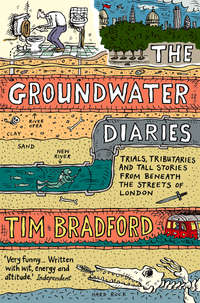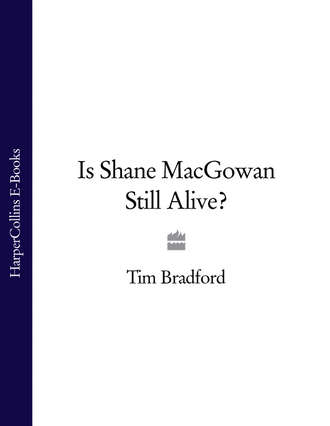
Полная версия
Is Shane MacGowan Still Alive?
What really annoyed me was that I wished this bloke was a nice friendly beggar who conformed to genteel ideas of homelessness, like the old Irish fellow further up Fulham Palace Road who stands in a doorway near the shoe shop, and who never wants money, just things to stare at.
My flat is, believe it or not, at the epicentre of old-fashioned tramp activity in the South Hammersmith area. Tramps must be descended from some ancient race that are tuned into ley lines which converge on my flat, or are inexorably drawn here by electromagnetic forces that we house dwellers don’t yet understand. In my more fanciful moments I think to myself that I might be The King of the Tinkers and they have come to claim me as their own. For much of the time I certainly look like a trainee tramp. Hair virtually down to my shoulders, a week’s worth of blotchy, sandpaperish stubble. Crappy old clothes (I’ve only been shopping for clothes twice since 1989).
My aforementioned ‘favourite tramp’ – whose name is Brendan and who comes, originally, from Co. Tyrone – leans against an electrical meter next to the newsagents nearest Fernando’s café on Fulham Palace Road. He patrols from there down to the doorway next to Luigi’s pizza place about two hundreds yards further south.2 I’ve only seen him away from this area twice. Once on King Street opposite the Living department store (London’s only Third-World shopping experience. They’ve got a couple of items and you never get served because the staff are always on the phone – Now gone as well. A curse!). Brendan forages locally and lives on what he can find – usually some form of superbrew extra-strong lager which, in accordance with the manufacturer’s specifications, turns immediately and magically into urine as soon as it is swallowed.
Once I happened to be sitting on an eastbound Hammersmith and City Line train at the Hammersmith terminus, reading a collection of John B. Keane’s essays and stories in an attempt to travel to Ireland for less than a tenner (I try to save money by applying for those cheap airline ticket offers but they seem to get booked up years in advance). I was reading a chapter entitled ‘My Personal Tramp’ when he – My Favourite Tramp – sat down opposite me. I wanted to say to him – I didn’t know his name then – ‘Well, do you know what? You, Mr Tramp, are my favourite tramp in all the world, and I’ve just found this story called ‘My Personal Tramp’. And here you are on the train with me. Incredible coincidence, is it not?’ I could tell from his worn-out, sad-eyed expression that he would not, in fact, find it incredible, he would simply think I was some ranting nutter and would probably get quietly off the train and move up a couple of carriages. So I didn’t say it.3 Some facts – tramps’ hair goes thick because the alcohol lowers their testosterone levels. They stand in overcoats staring off into nothingness. Many tramps are like angels and think other people can’t see them.
Then it happened. Ideas that had obviously been kicking around in my brain for a while decided to join forces. I thought about when I was seventeen, and obsessed with Jack Kerouac, when life seemed full of possibilities, when a car was a symbol of adventure and freedom.4 I was struck with the idea of heading off like Sal and Dean into the west, except I’d be doing it in this pretty little bright-red girl’s car, with a guitar and a crate of beer in the boot.
I had a feeling my mate Terry might fancy the trip. A knackered-looking handsome Irish raconteur, Terry looks vaguely like Sean Hughes, that knackered-looking handsome Irish raconteur. Which was ironic, as he had bumped into Sean Hughes several times at after-hours pubs and clubs and would invariably try and get into an argument with him. Usually because Terry was about to get off with a girl who thought he was Sean Hughes, then the real Sean Hughes would come along and spoil it. Like a Brian Rix farce, really. Or a Brian Rix farce co-written by James Joyce:
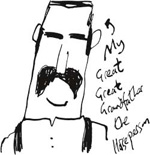
What the Finlan saw a Butler sore her Mother Mary.
(Scene – late nightshite midnight black jean bar under the chip smell tourist choking Tottenhemhem Caught Road. Finoola, Assumpta, Terry in chitchat inebriation)
Terry: Wear you froming to?
Assumpta: To? To? From? Live?
Terry: Chunky fleshy Finoola.
Finoola: The beer-stained sweat of old pine, belly stubble shaved.
Assumpta: Are you Sean Hughes?
Terry: Me funny Sean. Sunny, heavy-lidded sad Sean.
Sean: No me real deal feelme funny Sean. Who are you?
Terry: Doppelganger boy. Johnny Stalker. Johnny Walker.
Assumpta: Double Sean bedfun thrusting, eh Sean?

Anyway, I put it to Terry that the trip might be a good laugh. I said something like, ‘Let’s go off to Ireland for a week or so, try and sell the car, meet people who know the truth, get drunk, stand on mountain tops, go painting, sit in pubs listening to old men’s stories, laugh at and fall in love with mad Irishwomen, shout on the western edge of the world, sing folksongs, cry in the rain, puke in soft green fields, catch a moving statue and put it in our pocket.’
Terry took a sip of his pint and smiled at me. ‘Argh, yeah, why not?’
I regularly wander through Hammersmith and see Irish faces everywhere – heavy-set red-haired women, beautiful dark-haired girls, old guys with lined faces and sad eyes, tiny, grinning leprechauns made of felt who sing ‘When Irish Eyes are Smiling’ when you press their bellies. Hammersmith is an old Irish area. At present around eight per cent of the population of the Hammersmith postal district is Irish born – the figure for London as a whole is four per cent and one and a half per cent for Britain (from the 1991 census). It’s hard to know the figures for second- or third-generation Irish, the fresh-faced youngsters who choose to spend their evenings bashing away on bodhrans at the wonderful and lovely Hammersmith Irish Centre. This hive of Celticity is opposite St Paul’s church, round the back of Marks & Spencer with a good view of the flyover and its dark underbelly and of Coca Cola’s UK headquarters. It’s a yellowy brick building built in the mid-nineties. They run music, history, language and dance courses as well as occasional gigs and Irish music sessions and manages to appeal to the generation who came over after the War with stout and dance-hall music coursing through their veins as well as the kids brought up in the borough on hip hop and alcopops. It’s at the north-west end of what I regard as the Irish village of Finnegania6 – the spiritual centre of which is a discarded can of Guinness under the flyover which can be reached by crossing over the curve of the A4 and walking round the Apollo Theatre.
Inside the centre it’s very pale and high ceilinged, perhaps in an attempt to be like a church, although the atmosphere is more akin to an English village hall, the world of amateur dramatics and pantomimes, cake stalls and tombola, prized marrows and dollies made of wicker, the tables left over from university seminar rooms. Looking at the group of lads with their great faces and lost eyes, come to hear their grandchildren play the penny whistle or sing a ballad, I couldn’t help thinking that this scene should be a smoky low-slung pub in the forgotten back streets of a midlands Irish country town.
The workshop was a collection of musicians of all ages and talents. Whistle players, people on squeezebox, uillean pipes, banjos, guitars. The music sounded like Irish music yet didn’t really ever get going. The notes were right and the rhythm and speed were there but something was missing. A bloke who looked like Gerry Adams, President of Sinn Féin, was sat at a table surrounded by friends and family. When a jig came on, Gerry started dancing. Do you reckon that’s Gerry Adams? I said to my friends. No they said, it isn’t. Well it looks like him to me. I wonder what he’s doing here. Gerry Adams was dancing away with a baseball cap back to front on his head. Look at him. I’m not sure what the hard-liners of the IRA would think if they could see him now. That’s not Gerry Adams, Tim. You’d think, if he’s going to make a public appearance like this, that he’d have learned to dance properly. Still, I bet he can dance better than Ian Paisley. The music workshop group started to crank it up a bit. Ffaafnaaa nfffnaa twiddleidsleeeeeeeeee ggieee doo deeed didddle dee deee did diddd ddiiiidie dieeeeiieee … pipes and fiddle and accordion, more relaxed this time and my foot started to tap. Then a middle-aged guy took the microphone and introduced a couple of female singers. They did ballads, one in a high-pitched and haunting style about some tragedy or other, then a slightly younger girl did ‘The Raggle Taggle Gypsy’ followed by something about Johnny being the handsomest in the village (it’s always Johnny isn’t it, never Tim. How come it’s never ‘but Tim was the tallest and fairest and cleverest and funniest and most talented of them all’? – if there are Tims in Irish folk songs I’m pretty sure they’ll almost always be village idiots or something.)7

Finnegan’s Wake,8 just round the corner, is a pub that nobody should go to, some big brewer’s mangled attempt to reinvent the concept of Irish pub-going. It is a brand, a kind of corporate kit pub, except you pronounce the k as in sh. There are several of them dotted around London. I do know what I’m talking about here because I unfortunately am sucked into it from time to time by its possible promise of wild-haired colleens dancing on the tables. And the footy.
This Hammersmith version is like a west-of-Ireland theme park set in a grubby looking thirties building. Two towering slot machines guard the main entrance, like the giants Gog and Magog of the City of London, winking their multicoloured lights at each magical drinking warrior who enters the establishment. There are dark brown wooden floorboards, old newspapers and Irish posters all over the walls and ceilings. A violin case here. An accordion there. Near one of the several TV screens that pump out constant satellite sport is an old brown briefcase with the words MICHAEL O’MALLEY, LEGAL SECRETARY written on it in thick white paint (or possibly thin mashed potato). On the other side of the pub is a wooden shamrock (Is it, I wonder, the magic one ex-President Mary Robinson gave to Javier Pérez de Cuéllar, the former head of the UN, to ward off the evil machinations of Boutros Boutros-Ghali?). At various points there are pots and pans and stuff – basically all sorts of ill-thought-out cultural flotsam.
And the clientèle are just too perfect – perhaps they’re actors. A group of raucous red-haired women sit at a table in the middle, carousing and eyeing up the blokes. An old fellow with bulbous red nose and the look of a noble Gaelic poet nurses a pint of stout near the door. Young couples stare into each other’s eyes. A group of young Irish lads in leather jackets and real haircuts crack jokes and stare off into the distance at imaginary Nicole Kidman lookalikes running across a mountain top. The Irishness is suffocating, but it’s a joke, a shell, a thin layer of treacle. I can’t even remember what the pub was like before it was Finneganed, but probably just some nondescript and harmless local boozer.
When I first arrived in London in 1988, it was still bursting with authentic Irish pubs – ramshackle Victorian or Edwardian edifices which dominated the village high streets and side roads of the city – Muswell Hill, Walthamstow, Shepherd’s Bush, Hammersmith, Hoxton, Ladbroke Grove, Leyton. They may not have had the insignia of boozers back in Ireland – the name of the proprietor painted bright above the front window – but went by mostly prosaic English names, the Bells, Red Lions, White Harts or slightly more obscure monikers like Pelican or Green Man – but everybody knew what they were – and a high proportion of the drinkers within (or if not them, their parents) would have hailed from Ireland.
A creak of the flaky-painted door with its carved-pattern glass and you would enter into a main area of cigarette smoke, alcohol breath, crap aftershave (has anyone ever bettered Old Spice as a flowery counterpoint to the acid stink of maleness?), the crack of pool ball and blur of voices slightly rasping and off key like the trombone and baritone section of a school wind band. Decades of tobacco smoke were caked into the walls. The breathtakingly high, ornate ceilings made them seem like cathedrals of drinking, places of worship for those to whom the Sunday lunchtime pint was the spiritual high point of a week of grind. And the six other days of the week were quite good as well. The landords would either be big, farm-fed, red-faced, two- or three-chinned prop forwards, or red-haired whippet-like gone-to-seed lads with nervous darting eyes and a graceful way on the dancefloor at wedding receptions. Reddish carpet blotched with unidentifiable stains and, like the ageing clientèle, marinated in beer. Scuffed fittings, post-plush velveteen benches to the walls for the older hands to sit side by side, watch the world go by and say that they’d ‘seen it all before’.
The last four years have seen a big change – theme pubs, fun pubs, chain pubs – whatever you want to call them – have been springing up all over the place. Scruffy Murphys, Finnegan’s Wakes, O’Neills, Waxy O’Connors, Bodhran Barneys, Linus the Leprechaun’s Happy Shamrocks (OK, I made that one up). The Irish theme pub has not only arrived in London, it has taken over. What the marketing managers either fail to realise (or more probably don’t care about) is that this has created a shift in attitudes towards Irish culture. What used to be thought of as ancient, romantic and perhaps with a bit of ‘edge’ are now regarded as tacky eyesores, smart-fitted commercial machines with the ubiquity of international high street brands like McDonalds. Real drinkers now eschew a visit to the local Irish pub because it suggests frivolity where once it denoted authenticity, mindless fun where once there was both pleasure and pain, shallowness where once was an almost religious need to get shit-faced. Discord where once there was close harmony singing.
Some might argue that this is a positive aspect of what is jocularly known as the Celtic Tiger, the hard-driving Irish economy of the mid- to late-nineties, that it shows Ireland has become a real country at last and not some has-been backwater, a vessel for nostalgia freaks who dwell on the past, that it is creating new (and annoying) ideas of Irishness, reinventing itself for the new millennium. For those who frequent the places and like to get off on the nuances of culture, history and habit while fulfilling their alcoholic-unit quota, this is bullshit. These pubs are a fake validation of the ridiculous chirpy good-time Oirish vibe (the ones that Americans love so much). Every pint we have in these places is an encouragement for marketing men to rip off and parody a vibrant culture and steal its images. (Pause for breath, see Appendix.)
Down the cold, forgotten warehouse road that leads to the river – past the scrappy hedges and damp walls – lay the ghost of a car, a burned-out Ford Escort of early eighties’ vintage, a pagan sacrifice, a love rite to a favourite Spice Girl from some self-styled juvenile delinquent. Behind the poorly made wooden fence, idle bulldozers waited for the next morning’s shift when time will move nearer another new block of viciously ugly luxury apartments with river views. I inspected the car, thinking that it used to belong to somebody but now no-one, as a police helicopter waited overhead, then somewhere a siren, then a gunshot sounded, or was it a criminally faulty gas cooker perhaps taking the heads off some eager diners at a student lager and spag bol evening?
The light was going down, reflecting warmth against the scaffolding on the Harrod’s Depository. Or ‘Harrods Suppository’, as one of my friends used to call it in all innocence, the same friend who thought that West Ham played at Hammersmith. Which, when you think about it, isn’t so strange. Seeing the shell of a motor made me decide that I should check the battery on the little Corsa. I didn’t want it to go flat again. It would soon be going on a journey.
1 Eric Heiden, say. Not Wilf Thingy, the plucky English bloke.
2 In a more recent, deadline-challenging development, Fernando’s greasy spoon business has been bought out and is now another Italian restaurant.
3 A while later I was writing up the notes to this chapter on the same train and a modernist tramp sat down next to me, smelling of BO, roast kidney and special brew, and fags, his purple jeans darkened with recently squirted urine. Was I inadvertently attracting the tramps while writing about them?
4 In my mid teens I spent day after day reading my favourite authors, Jack Kerouac and George Orwell. I loved Down and Out in Paris and London but there was also something slightly warped about it, the sordid voyeuristic slumming of a middle-class bloke with too much time on his hands. Incidentally, how do you know if you’re a tramp? Is it genetic, mapped out generations before? One of my ancestors used to head off from his Buckinghamshire village home at regular periods to pubs and clubs in the Midlands to play the squeeze box and the spoons. My great grandmother’s family in Yorkshire were horse people, which was apparently a euphemism for gypsy stock. I’d seen a photo of her father, looking tall and strong with a big black Victorian moustache. I imagined him looking proud on horseback.
6 Historically speaking, the Irish village in Hammersmith, at least in the nineteenth century, was actually about half a mile to the north-west at Brook Green.
7 As well as the Irish centre there’s a thriving busker scene in west London, usually situated in the subway at the top of Fulham Palace Road. The best of them is known simply by his unofficial stage name Bloke with Organ in a Wheelchair. He’s a fat old fellow with grey hair and glasses; a more recent addition to the scene. He rests his organ on a stand and plays Irish classics, usually with a tinny drum machine diddling away in the background. One of his better numbers is ‘When Irish Eyes are Smiling’, which goes something like this: Bum bh bum phh daao daaaoooo daooo daoaooo daooo daoo daooo Bum bh bum phh daao daaaoooo daooo daoaooo daooo daoo daooo Bum bh bum phh daao daaaoooodaooo daoaooo daooo daoo daooo. tinkle dee dee deeeeeeeeeee’. I once saw him stand up and pack all his stuff away and for a second I was outraged that I’d given him money not because of the music but because of his disability but then I thought it serves me right, transport is a big problem in London when you’re getting to gigs.
8 Finnegans Wake is the James Joyce book that nobody has read. Ulysses is also the James Joyce book that nobody has read, but everyone claims they have (that’s why it is now the Citizen Kane of novels, up there at the number one spot in recent lists of the best novels of the century). Finnegans Wake was Joyce’s last book, his mangled and messianic attempt to reinvent the language and structure of the novel and piss people off at the same time (he was probably much more successful at the latter). Of course, I don’t really know what I’m talking about, not having read it.
IRISH MYTHS & LEGENDS 2 Hey, Mister, Got any Tayto?
Most Irish pubs worth their salt and vinegar will serve Tayto, the Irish potato crisps. To the untrained palate (i.e. mine) they taste exactly the same as any other kind of crisp. But to the rootless Irish person drifting round the world dreaming of home, they are a beautiful and rare foodstuff which transports the eater on a mystical journey back to Erin’s wild shores. People buy boxloads of the stuff saying they are addicted to them. They’re dry, slightly greasy and very cheese and oniony. But you don’t understand, says the fat person stuffing their face with crisps. Lots of Irish food is special like that, particularly if it’s hard to come by. Here’s a brief selection:
Superquinn Sausages
You’ve got to try some Superquinn sausages, I was told. I sat down to my fry-up with these little fried rabbit droppings at the side of the plate. Mmmm, these fried rabbit droppings look delicious. But where are the Superquinn sausages? Hey, those are the Superquinn sausages. Ah, stop messing.
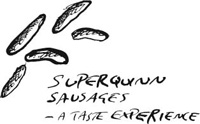
Irish Butter
Irish people abroad will drive around a new city for days looking for Irish butter. I mean, butter is butter. It all tastes the same to me. But they like their traditional Irish butter – like Kerrygold. Kerrygold was actually created by Heinz magnate Tony O’Reilly for the Irish Dairy Board in the mid-sixties. But if you mention this to an Irish person, it’s as if you have criticised Michael Collins or the drummer out of u2. Kerrygold is simply a recent brand with an invented fictional heritage, like the crap beer you get in many new Irish pubs. Hey, managed to get a dig in at crap Irish pubs again there. The proofreader’s obviously not concentrating.
Ring Cheese
In the long-gone days when I played rugby, the concept of ‘ring cheese’ would have been enough to send me into paroxysms of mirth before collapsing on the floor in a soggy puddle of giggles (at least I hope that’s giggles and not the product of the ‘cream cracker game’ – oh, never mind). Ring is an Irish speaking area in Waterford. Cheese is a dairy product made from milk and – but you probably know that already.
Chocolate Kimberleys
Ordinary Kimberley biscuits are, apparently, disgusting and taste like cardboard. But you’ve got to taste Chocolate Kimberleys. They’re simply heaven. You’re supposed to leave them in the fridge for a while. Mmmmmm. It’ll be an experience you’ll never forget. It’s a biscuit thing with marshmallow in, a bit like Wagon Wheel but not as tasty or big.
Red Lemonade
Lemons are yellow but lemonade is red, at least in Ireland. White lemonade, or to be more precise, see-through, is for amateurs. Real drinkers take red lemonade with their tipple. Is it like Lucozade or Tizer? I asked in all innocence. Don’t be silly. It’s lemonade made with special red lemons. Right. But it’s not really red, it’s orange.

VIKING TOWNDublin
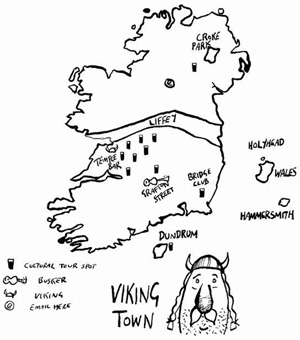
Visions of Beer and Loathing on the Road to Holyhead Hammersmith to Dublin
As usual I had left everything until the last minute. This was fine with me – in a way I was happier like that because it didn’t give me too much time to cock things up. When other people were involved, however, it became more of a problem.1 I had only mentioned to Terry a couple of days earlier that I was definitely heading off at this time. He’s usually pretty spontaneous, but this was short notice even for him. I’d spoken to him earlier in the day and he said he’d call some time in the evening if he’d managed to get it all together. I smelled disaster already (it smells sweet and sickly like treacle pudding except it’s also as dry as chalk on a blackboard). Why couldn’t I organise anything properly? Terry would most likely be in a pub doing the crossword and thinking subconsciously about Ireland. That was something, I suppose. I sat in the little box room at the end of the flat and stared down at The Car, waiting for the phone to ring.


